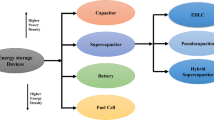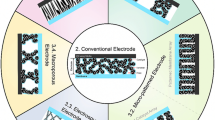Abstract
Using the well-known Cottrell asymptote, voltage-step transient (VST) experiments in a two-electrode cell may provide data on the bulk concentration and diffusion coefficient of a working depolarizer, essential for interpretation of liming-diffusion-current (LDC) experiments. However, the Cottrell asymptote is never applicable in the early stages of the voltage-step transient process. There are three additional transport resistances to the basic diffusion transport that cannot be neglected at extremely high initial currents: Faradaic resistance at the working electrode surface, overall Ohmic losses in the electrochemical cell, and a possible galvanometric constraint in the outer circuit, involving the galvanometer, current follower, potentiostat, etc. The effect of these additional transport resistances on the transient current at higher polarization voltage is non-linear. In the present analysis, a 1D approximation is used, assuming tacitly uniform accessibility of the working electrode and negligible transport resistances at the counter electrode. The Faradaic resistance of a redox couple O + ne − = R according to Butler–Volmer electrode kinetics is considered. The results of 1D theory are corrected for edge effects using the Oldham asymptote. The effect of convection at longer times is included using the recent model of a transient process for circular working electrodes in the LDC regime.










Similar content being viewed by others
Abbreviations
- A :
-
Effective area of working electrode, m2
- A ∞ :
-
area of ideally smooth working electrode, m2
- B :
-
≡ \( D_{O}^{1/2} c_{O}^{B} /D_{R}^{1/2} c_{R}^{B} \), transport parameter
- C :
-
Cottrell coefficient (m s−1/2)
- c, \( c_{O,R}^{B,W} \):
-
Molar concentration of depolarizers and their boundary values (mol m−2 s−1)
- D, D O,R :
-
Coefficient of diffusion; values for the components (m2 s−1)
- \( d_{T}^{ - 1/2} \) :
-
Semi-integral operator
- E :
-
= Exp[P]
- f :
-
= (E − 1)/(E+B), Nernst–Petersen factor
- G :
-
= k G /k S , normalized galvanometric constraint
- I :
-
Current (A)
- J O,R :
-
Diffusion fluxes of depolarizers at surface (mol m−2 s−1)
- K :
-
= \( k_{BV} (c_{O}^{B} )^{1 - \beta } (c_{R}^{B} )^{\beta } \), modified rate constant (mol m−2 s−1)
- k :
-
= I/(nFA \( c_{work}^{B} \)), mass-transfer coefficient (m s−1)
- k BV :
-
Rate constant factor in Butler–Volmer kinetics (m s−1)
- k C :
-
= U/(nFAR C \( c_{work}^{B} \)), Ohmic limit for k(t) (m s−1)
- k G :
-
= I G /(nFA \( c_{work}^{B} \)), galvanometric constraint (m s−1)
- k S :
-
= μk C , starting (upper) limit for k(t) (m s−1)
- L C :
-
Equivalent resistor length (m)
- M :
-
≡ K/k C
- nF :
-
The charge transfer per 1 mol of the working depolarizer (C mol−1)
- N = N(T):
-
≡ k/k S , normalized flux
- N L :
-
Solution to the linearized transport equation
- O, R :
-
Oxy- and Red- forms of the redox couple, O + ne − ↔ R
- P :
-
≡ −U nF/RT, normalized voltage; F = 95608 C mol−1, Faraday constant; R = 8.313 J K−1 mol−1, universal gas constant; T, absolute temperature
- R C :
-
Ohmic resistance of the cell (Ω)
- t :
-
Time from the initial voltage step
- t S :
-
≡ (C/k S )2, characteristic lag time (s)
- T :
-
≡ t/t S , normalized time
- U :
-
Constant voltage between working and counter electrodes (V)
- W = W(T):
-
≡ 1 − \( c_{O}^{W} /c_{O}^{B} \), normalized concentration driving force (for cathodic depolarizer)
- z :
-
Normal distance to the working electrode (m)
- β :
-
Symmetry coefficient in Butler–Volmer kinetics
- Λ[N]:
-
United boundary-value constraint for the concentration driving force
- ∂ T :
-
Partial derivative with respect to T
- μ :
-
≡ k S /k C
- θ :
-
= π/4, the asymptotic divide time
- η :
-
= U − IR C , overvoltage (V)
- κ :
-
Specific conductivity of the bulk solution (S m−1)
- δ :
-
≡ D/|k|, Nernst diffusion layer thickness (m)
- c B,W :
-
Bulk or Wall compositions of the solution
- C :
-
Ohmic resistance of the two-electrode cell
- G :
-
Galvanometric constraint
- NP :
-
Reversible electrodes according to the Nernst–Petersen rule
- c O,R :
-
Oxy- or Red- form of redox couple
- S :
-
Start of the process
- ED:
-
Electrodiffusion
- LDC:
-
Limiting diffusion current
- VST:
-
Voltage-step transient
References
Vetter KJ (1967) Electrochemical kinetics. Academic Press, New York
Newman JS (1973) Electrochemical systems. Prentice Hall, Englewood Cliffs
McDonald DD (1977) Transient techniques in electrochemistry. Plenum Press, New York
Sobolik V, Tihon J, Wein O, Wichterle K (1998) J Appl Electrochem 28:329
Wein O, Tovchigrechko VV, Sobolik V (2006) Int J Heat Mass Transfer 49:4596
Wein O (1991) J Appl Electrochem 21:1091
Wein O (1993) Transient process in a redox system started by a large voltage step. Elektrokhimiya 29:8; in Russian
Vielstich W, Delahay P (1957) J Am Chem Soc 79:874
Oldham KB, Spannier J (1974) Fractional calculus. Academic Press, New York
Oldham KB (1981) J Electroanal Chem 122:1
Aoki A, Osteryoung J (1984) J Electroanal Chem 160:335
Wein O, Assaf FH (1987) Collect Czech Chem Commun 52:848
Wein O (2010) Proceedings of Int. Congr. CHISA 2010
Barz F, Bernstein C, Vielstich W (1984) Adv Electrochem Electrochem Eng 13:261
Acknowledgment
Support by the Czech Science Foundation (GACR) through the projects 104/08/0428 and 104/09/0972 is acknowledged.
Author information
Authors and Affiliations
Corresponding author
Rights and permissions
About this article
Cite this article
Wein, O., Tovchigrechko, V.V. Voltage-step transient on circular electrodes. J Appl Electrochem 41, 1065–1075 (2011). https://doi.org/10.1007/s10800-011-0288-x
Received:
Accepted:
Published:
Issue Date:
DOI: https://doi.org/10.1007/s10800-011-0288-x




